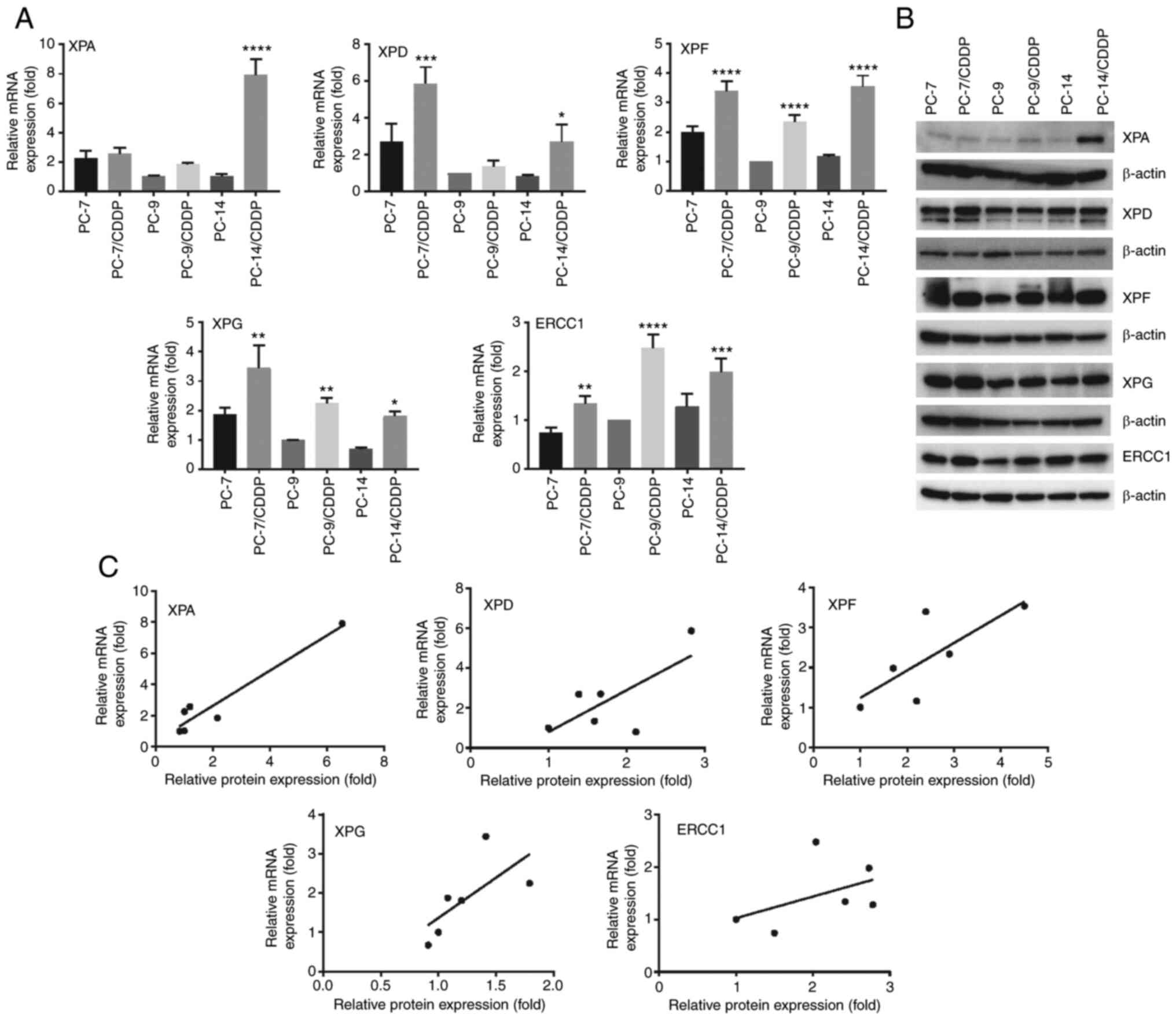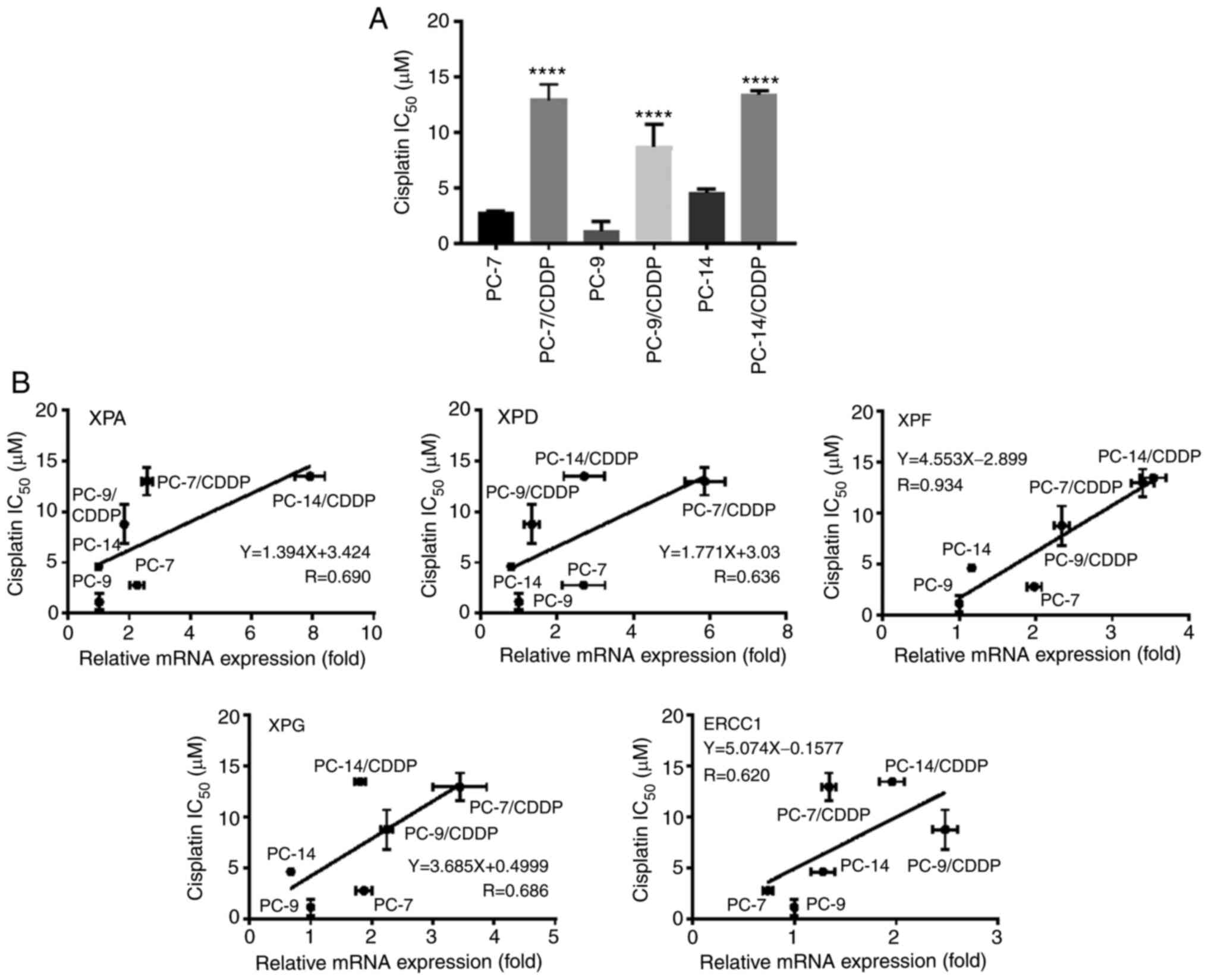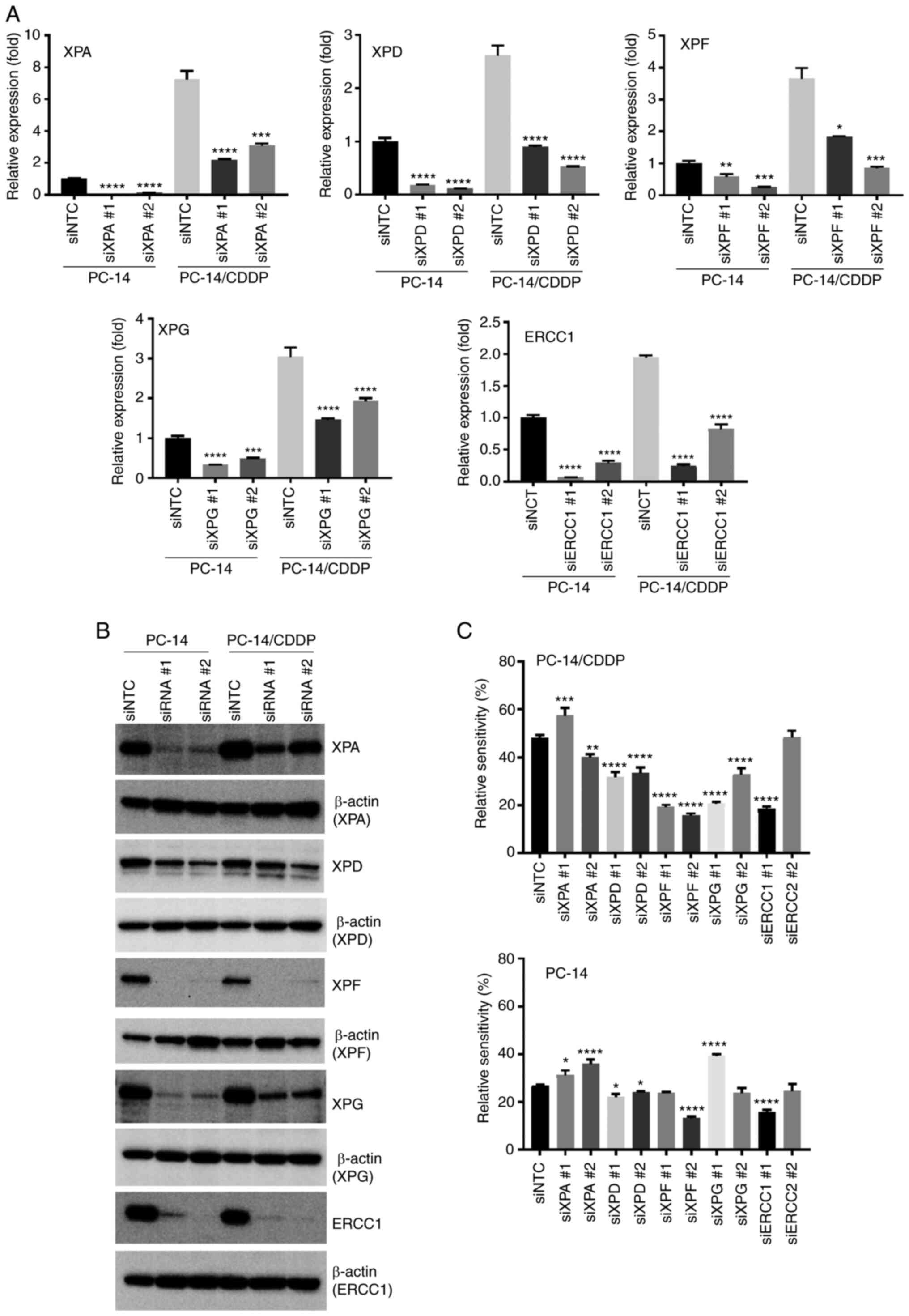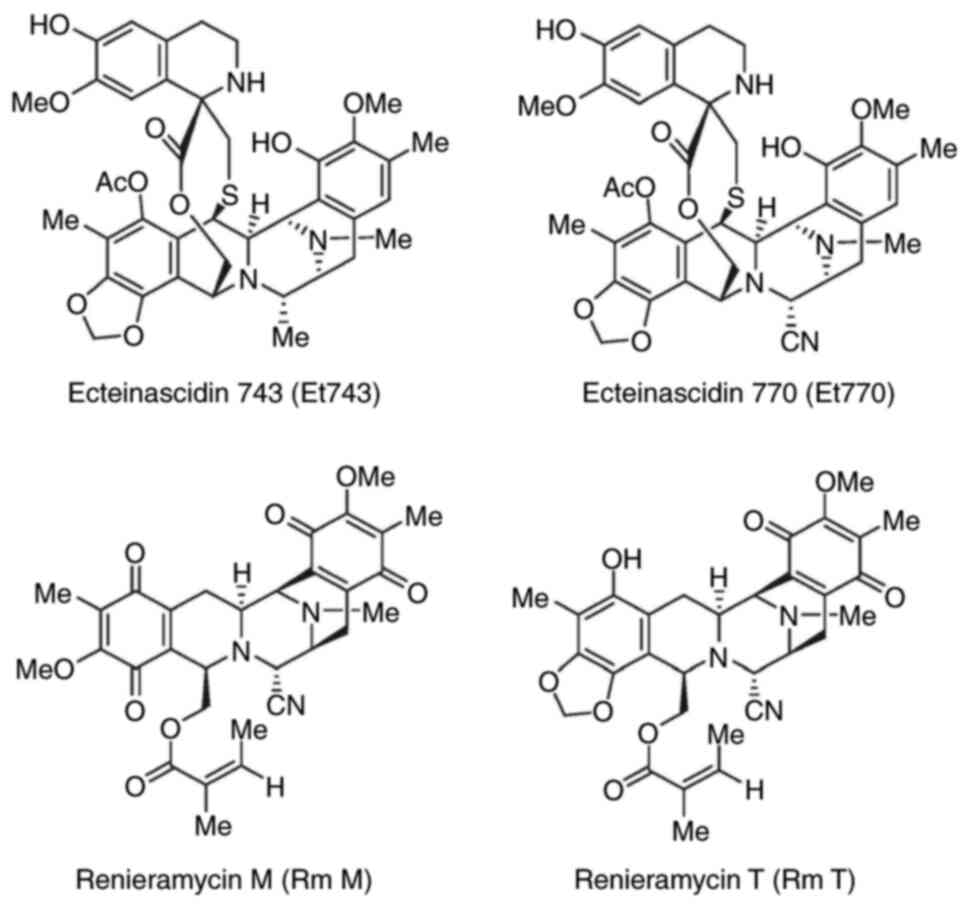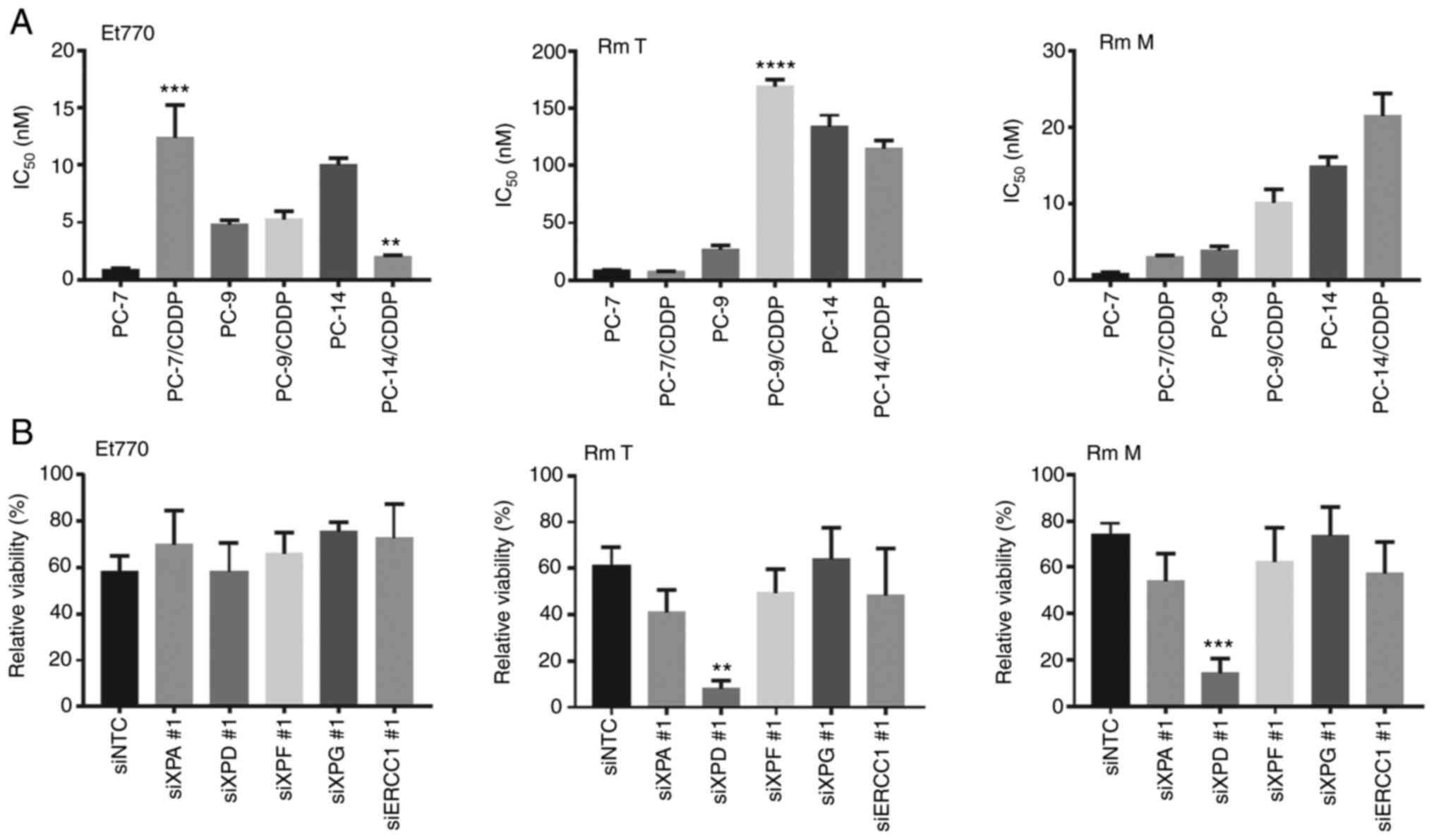|
1
|
Zappa C and Mousa SA: Non-small cell lung
cancer: Current treatment and future advances. Transl Lung Cancer
Res. 5:288–300. 2016. View Article : Google Scholar : PubMed/NCBI
|
|
2
|
Takano N, Ariyasu R, Koyama J, Sonoda T,
Saiki M, Kawashima Y, Oguri T, Hisakane K, Uchibori K, Nishikawa S,
et al: Improvement in the survival of patients with stage IV
non-small-cell lung cancer: Experience in a single institutional
1995–2017. Lung Cancer. 131:69–77. 2019. View Article : Google Scholar : PubMed/NCBI
|
|
3
|
Saito M, Shiraishi K, Kunitoh H,
Takenoshita S, Yokota J and Kohno T: Gene aberrations for precision
medicine against lung adenocarcinoma. Cancer Sci. 107:713–720.
2016. View Article : Google Scholar : PubMed/NCBI
|
|
4
|
Suzuki T, Nishio K and Tanabe S: The MRP
family and anticancer drug metabolism. Curr Drug Metab. 2:367–377.
2001. View Article : Google Scholar : PubMed/NCBI
|
|
5
|
Shen DW, Pouliot LM, Hall MD and Gottesman
MM: Cisplatin resistance: A cellular self-defense mechanism
resulting from multiple epigenetic and genetic changes. Pharmacol
Rev. 64:706–721. 2012. View Article : Google Scholar : PubMed/NCBI
|
|
6
|
Gilson P, Drouot G, Witz A, Merlin JL,
Becuwe P and Harlé A: Emerging roles of DDB2 in cancer. Int J Mol
Sci. 20:51682019. View Article : Google Scholar : PubMed/NCBI
|
|
7
|
Bowden NA: Nucleotide excision repair: Why
is it not used to predict response to platinum-based chemotherapy?
Cancer Lett. 346:163–171. 2014. View Article : Google Scholar : PubMed/NCBI
|
|
8
|
Spivak G: Nucleotide excision repair in
humans. DNA Repair (Amst). 36:13–18. 2015. View Article : Google Scholar : PubMed/NCBI
|
|
9
|
Zhang Y, Cao J, Meng Y, Qu C, Shen F and
Xu L: Overexpression of xeroderma pigmentosum group C decreases the
chemotherapeutic sensitivity of colorectal carcinoma cells to
cisplatin. Oncol Lett. 15:6336–6344. 2018.PubMed/NCBI
|
|
10
|
Stevens EV, Nishizuka S, Antony S, Reimers
M, Varma S, Young L, Munson PJ, Weinstein JN, Kohn EC and Pommier
Y: Predicting cisplatin and trabectedin drug sensitivity in ovarian
and colon cancers. Mol Cancer Ther. 7:10–18. 2008. View Article : Google Scholar : PubMed/NCBI
|
|
11
|
Pajuelo-Lozano N, Bargiela-Iparraguirre J,
Dominguez G, Quiroga AG, Perona R and Sanchez-Perez I: XPA, XPC,
and XPD modulate sensitivity in gastric cisplatin resistance cancer
cells. Front Pharmacol. 9:11972018. View Article : Google Scholar : PubMed/NCBI
|
|
12
|
Zewail-Foote M and Hurley LH:
Ecteinascidin 743: A minor groove alkylator that bends DNA toward
the major groove. J Med Chem. 42:2493–2497. 1999. View Article : Google Scholar : PubMed/NCBI
|
|
13
|
Takebayashi Y, Pourquier P, Zimonjic DB,
Nakayama K, Emmert S, Ueda T, Urasaki Y, Kanzaki A, Akiyama SI,
Popescu N, et al: Antiproliferative activity of ecteinascidin 743
is dependent upon transcription-coupled nucleotide-excision repair.
Nat Med. 7:961–966. 2001. View
Article : Google Scholar : PubMed/NCBI
|
|
14
|
Herrero AB, Martin-Castellanos C, Marco E,
Gago F and Moreno S: Cross-talk between nucleotide excision and
homologous recombination DNA repair pathways in the mechanism of
action of antitumor trabectedin. Cancer Res. 66:8155–8162. 2006.
View Article : Google Scholar : PubMed/NCBI
|
|
15
|
Tsujimoto M, Lowtangkitcharoen W, Mori N,
Pangkruang W, Putongking P, Suwanborirux K and Saito N: Chemistry
of ecteinascidins. Part 4: Preparation of 2′-N-acyl ecteinascidin
770 derivatives with improved cytotoxicity profiles. Chem Pharm
Bull (Tokyo). 61:1052–1064. 2013. View Article : Google Scholar : PubMed/NCBI
|
|
16
|
Sirimangkalakitti N, Chamni S, Charupant
K, Chanvorachote P, Mori N, Saito N and Suwanborirux K: Chemistry
of renieramycins. 15. Synthesis of 22-O-ester derivatives of
jorunnamycin A and their cytotoxicity against non-small-cell lung
cancer cells. J Nat Prod. 79:2089–2093. 2016. View Article : Google Scholar : PubMed/NCBI
|
|
17
|
Suwanborirux K, Amnuoypol S, Plubrukarn A,
Pummangura S, Kubo A, Tanaka C and Saito N: Chemistry of
renieramycins. Part 3.(1) isolation and structure of stabilized
renieramycin type derivatives possessing antitumor activity from
Thai sponge Xestospongia species, pretreated with potassium
cyanide. J Nat Prod. 66:1441–1446. 2003. View Article : Google Scholar : PubMed/NCBI
|
|
18
|
Daikuhara N, Tada Y, Yamaki S, Charupant
K, Amnuoypol S, Suwanborirux K and Saito N: Chemistry of
renieramycins. Part 7: Renieramycins T and U, novel
renieramycin-ecteinascidin hybrid marine natural products from Thai
sponge Xestospongia sp. Tetrahedron Lett. 50:4276–4278.
2009. View Article : Google Scholar
|
|
19
|
Rinehart KL, Holt TG, Fregeau NL, Stroh
JG, Keifer PA, Sun F, Li LH and Martin DG: Ecteinascidins 729, 743,
745, 759A, 759B, and 770: Potent antitumor agents from the
Caribbean tunicate Ecteinascidia turbinata. J Org Chem.
55:4512–4515. 1990. View Article : Google Scholar
|
|
20
|
Morikage T, Ohmori T, Nishio K, Fujiwara
Y, Takeda Y and Saijo N: Modulation of cisplatin sensitivity and
accumulation by amphotericin B in cisplatin-resistant human lung
cancer cell lines. Cancer Res. 53:3302–3307. 1993.PubMed/NCBI
|
|
21
|
Livak KJ and Schmittgen TD: Analysis of
relative gene expression data using real-time quantitative PCR and
the 2(−Delta Delta C(T)) method. Methods. 25:402–408. 2001.
View Article : Google Scholar : PubMed/NCBI
|
|
22
|
Chen SH and Chang JY: New insights into
mechanisms of cisplatin resistance: From tumor cell to
microenvironment. Int J Mol Sci. 20:41362019. View Article : Google Scholar : PubMed/NCBI
|
|
23
|
Le VH, Inai M, Williams RM and Kan T:
Ecteinascidins. A review of the chemistry, biology and clinical
utility of potent tetrahydroisoquinoline antitumor antibiotics. Nat
Prod Rep. 32:328–347. 2015. View Article : Google Scholar : PubMed/NCBI
|
|
24
|
Suwanborirux K, Charupant K, Amnuoypol S,
Pummangura S, Kubo A and Saito N: Ecteinascidins 770 and 786 from
the Thai tunicate Ecteinascidia thurstoni. J Nat Prod.
65:935–937. 2002. View Article : Google Scholar : PubMed/NCBI
|
|
25
|
Yokoya M, Toyoshima R, Suzuki T, Le VH,
Williams RM and Saito N: Stereoselective total synthesis of
(−)-renieramycin T. J Org Chem. 81:4039–4047. 2016. View Article : Google Scholar : PubMed/NCBI
|
|
26
|
Ohmori T, Morikage T, Sugimoto Y, Fujiwara
Y, Kasahara K, Nishio K, Ohta S, Sasaki Y, Takahashi T and Saijo N:
The mechanism of the difference in cellular uptake of platinum
derivatives in non-small cell lung cancer cell line (PC-14) and its
cisplatin-resistant subline (PC-14/CDDP). Jpn J Cancer Res.
84:83–92. 1993. View Article : Google Scholar : PubMed/NCBI
|
|
27
|
Suzuki T, Nishio K, Sasaki H, Kurokawa H,
Saito-Ohara F, Ikeuchi T, Tanabe S, Terada M and Saijo N: cDNA
cloning of a short type of multidrug resistance protein homologue,
SMRP, from a human lung cancer cell line. Biochem Biophys Res
Commun. 238:790–794. 1997. View Article : Google Scholar : PubMed/NCBI
|
|
28
|
Nishio K, Nakamura T, Koh Y, Suzuki T,
Fukumoto H and Saijo N: Drug resistance in lung cancer. Curr Opin
Oncol. 11:109–115. 1999. View Article : Google Scholar : PubMed/NCBI
|
|
29
|
Jones M, Beuron F, Borg A, Nans A, Earl
CP, Briggs DC, Snijders AP, Bowles M, Morris EP, Linch M and
McDonald NQ: Cryo-EM structures of the XPF-ERCC1 endonuclease
reveal how DNA-junction engagement disrupts an auto-inhibited
conformation. Nat Commun. 11:11202020. View Article : Google Scholar : PubMed/NCBI
|
|
30
|
Mesquita KA, Alabdullah M, Griffin M, Toss
MS, Fatah TMAA, Alblihy A, Moseley P, Chan SYT, Rakha EA and
Madhusudan S: ERCC1-XPF deficiency is a predictor of olaparib
induced synthetic lethality and platinum sensitivity in epithelial
ovarian cancers. Gynecol Oncol. 153:416–424. 2019. View Article : Google Scholar : PubMed/NCBI
|
|
31
|
Cierna Z, Miskovska V, Roska J,
Jurkovicova D, Pulzova LB, Sestakova Z, Hurbanova L, Machalekova K,
Chovanec M, Rejlekova K, et al: Increased levels of XPA might be
the basis of cisplatin resistance in germ cell tumours. BMC Cancer.
20:172020. View Article : Google Scholar : PubMed/NCBI
|
|
32
|
Wang M, Li E, Lin L, Kumar AK, Pan F, He
L, Zhang J, Hu Z and Guo Z: Enhanced activity of variant DNA
polymerase β (D160G) contributes to cisplatin therapy by impeding
the efficiency of NER. Mol Cancer Res. 17:2077–2088. 2019.
View Article : Google Scholar : PubMed/NCBI
|
|
33
|
Jian J, Li S, Liu LZ, Zhen L, Yao L, Gan
LH, Huang YQ and Fang N: XPD inhibits cell growth and invasion and
enhances chemosensitivity in esophageal squamous cell carcinoma by
regulating the PI3K/AKT signaling pathway. Int J Mol Med.
46:201–210. 2020. View Article : Google Scholar : PubMed/NCBI
|
|
34
|
Li M, Chen R, Ji B, Fan C, Wang G, Yue C
and Li G: Contribution of XPD and XPF polymorphisms to
susceptibility of non-small cell lung cancer in high-altitude
areas. Public Health Genomics. 24:189–198. 2021. View Article : Google Scholar : PubMed/NCBI
|















